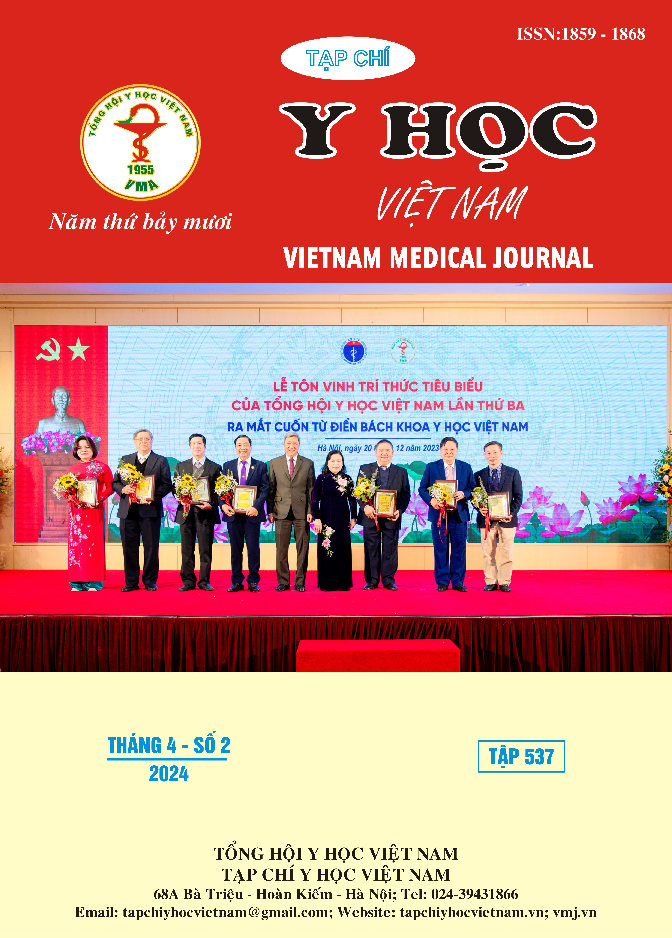COMPARISON OF CHANGES IN PAIN THRESHOLD BETWEEN ELECTRO-ACUPUNCTURE AND TAP-ACUPUNCTURE AT NEIGUAN AND HEGU POINTS ON THE RIGHT SIDE IN HEALTHY VOLUNTEERS
Main Article Content
Abstract
Objectives: Electroacupuncture (EA) is a popular treatment method and is gradually replacing traditional manual acupuncture (MA) to treat pain. However, whether EA is so popular because of its better pain relief effect than MA or because of the convenience that this method brings is still controversial. Neiguan and Hegu acupuncture points have been applied clinically and many studies have recorded pain-relieving effects on the head, face and neck area. However, studies have not recorded a change in pain threshold in the head, face and neck area when acupuncture is performed on one side of the body. Therefore, this study aims to compare the change in skin pain threshold between EA and MA at Neiguan and Hegu acupuncture points on the right side in healthy volunteers. Methods: Controlled intervention study, conducted on 30 healthy volunteers, was conducted at the Experimental Acupuncture Research Laboratory, Faculty of Traditional Medicine, Ho Chi Minh City University of Medicine and Pharmacy. Implementation period is from March 1, 2023 - April 28, 2023. Results: Both EA and MA methods increased the pain threshold in the head, face and neck area (p<005), the increase in pain threshold had no statistical difference between the two methods (p>0.05), and the unwanted effect noted was pain at the needle insertion site: 6.67% (EA), 13.33% (MA). Conclusion: EA and MA acupoints Neiguan and Hegu on the right can both increase the pain threshold in the head, face and neck area, both methods are safe.
Article Details
Keywords
electro-acupuncture, manual acupuncture, pain threshold, Neiguan, Hegu.
References
2. Ngô Thị Kim Oanh. Vùng giảm cảm giác đau ngoài da khi châm nhóm huyệt hoa đà giáp tích cổ 1, 2, 3, 4 trên người bình thường. Tạp chí Y học Thành phố Hồ Chí Minh. 2013; 18(1):13.
3. Trần Công Thắng, Mai Phương Thảo, Bùi Diễm Khuê. Giáo trình hệ thần kinh và hành vi. 2020: 137-190.
4. Farber PL, Tachibana A, Campiglia HM. Increased pain threshold following electroacupuncture: analgesia is induced mainly in meridian acupuncture points. Acupunct Electrother Res. 1997; 22(2):109-17.
5. Langevin HM, Schnyer R, MacPherson H, et al. Executive Board of the Society for Acupuncture Research. Manual and electrical needle stimulation in acupuncture research: pitfalls and challenges of heterogeneity. J Altern Complement Med. 2015 Mar;21(3):113-28.
6. Li Y, Yu Y, Liu Y, Yao W. Mast Cells and Acupuncture Analgesia. Cells. 2022;11(5):860.
7. Liu K, Jiang JF, Lu SF. [Effect characteristics and mechanism of acupuncture in autonomic nerve regulation]. Zhen Ci Yan Jiu. 2021; 46(4):41-335.
8. Niu X, Zhang M, Liu Z, et al. Interaction of acupuncture treatment and manipulation laterality modulated by the default mode network. Mol Pain. 2017.
9. Schliessbach J, Klift E, Arendt-Nielsen L, et al. The effect of brief electrical and manual acupuncture stimulation on mechanical experimental pain. Pain Med. 2011 Feb;12(2):268-75.
10. Shen YF, Younger J, Goddard G, Mackey S. Randomized clinical trial of acupuncture for myofascial pain of the jaw muscles. J Orofac Pain. 2009; 23(4):9-353.
11. Wang D, Shi H, Yang Z, et al. Efficacy and Safety of Transcutaneous Electrical Acupoint Stimulation for Postoperative Pain: A Meta-Analysis of Randomized Controlled Trials. Pain Res Manag. 2022.
12. Zaslawski CJ, Cobbin D, Lidums E, et al. The impact of site specificity and needle manipulation on changes to pain pressure threshold following manual acupuncture: a controlled study. Complement Ther Med. 2003 Mar;11(1):11-21.


